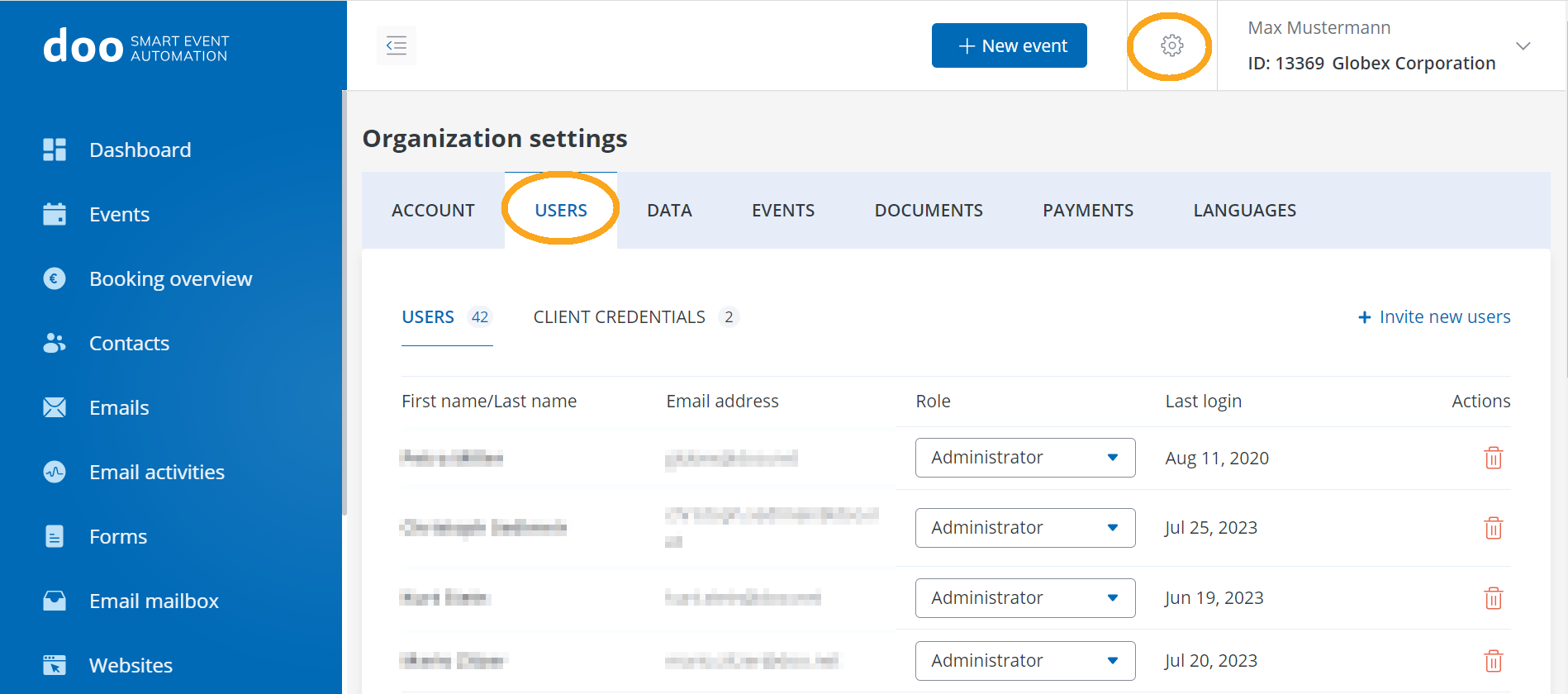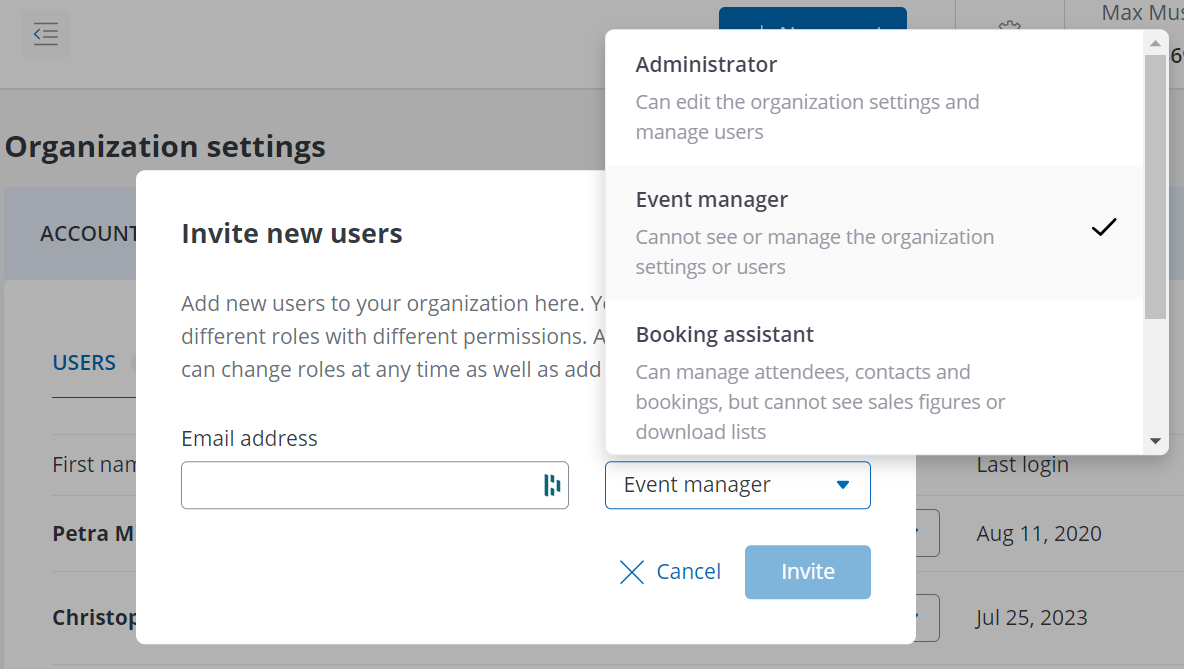-
General information
-
Account Settings
- Creating & managing your personal doo account
- Organization settings: Managing your account settings
- Multi-user: Working as a team
- How to reset your password
- Changing the email address of your doo account
- The doo account packages
- What can I do if a doo site does not load
- Adjusting standard labels and texts of the doo booking process
- How do I delete my account
- Payment Process: How to manage payment options
- Password Security using doo: What options are available?
-
Events
-
- Edit email contents
- Using placeholders in booking email templates
- How to adjust invoice contents
- Attendee tickets and QR code scanning
- What do doo tickets look like?
- E-mail attachments for bookers and attendee
- Certificates & Co: Create custom documents
- Define your own booking conditions
- Revenue Disbursement: Entering and editing invoice address & bank account information
- Create bilingual (multilingual) events
- Bookings with manual approval
- Create a waiting list
- Access codes and promotion codes: Discounted tickets for your participants
- doo Widgets: Integration into your own website
- doo Default Event Website and Custom Event Website
- How to create a booking process in english
- Providing flyers, event programs or direction sketches
- How does the booking process work for my attendees?
- How do I make test bookings?
- Creating exclusive registration access for selected contacts
- Delete ticket categories & change prices and sales periods after go-live
- Cancellation of events
- What are event fields and how do I use them best ?
- Shorten the booking process and prefill data: How to make the booking process as convenient as possible for bookers
- Tips for virtual events with doo
- Integration into your own Facebook page
- Event Templates: Creating templates for your events
-
Manage Bookings
- Manage bookings and attendees
- Monitoring incoming bookings
- The attendee overview
- Invitation list: Track the registration status of specific contacts
- Manual registration
- Resend automatically generated emails
- Rebooking: How to change existing bookings
- Cancellation & Refund Handling
- Booking self-service: Allow bookers to subsequently access and edit their bookings
- Download booking overview and attendee list
- Change of attendee data and invoice address
- Bank transfer: How to deal with pending transactions
- What to do, if someone has not received their confirmation e-mail or ticket
-
Contact Management
- Contacts: Introduction and Topic Overview
- Contact details: Collect cross-event contact information
- Overview contact data fields
- Managing contact data fields
- Creating contacts - How do contacts get into the doo contact center?
- Contact import - Bulk creation and editing of contacts
- Managing existing contacts
- Creating and managing contact groups
- Datamatching & Synchronization of booking data and doo contact
- Email subscriptions: Double opt-in & opt-out options at doo
- Deleting contacts
-
Emails
-
Websites
- The doo website editor: create an individual event page
- Mobile optimization: Customize your site for all your devices
- Installing different tracking tools on the website
- Creating a SSL certificat (HTTPS) to ensure data security
- Website Tracking: How to integrate doo into your Google Analytics To be Created
-
Additional Functions
- Optional Service: Refund handling via doo
- Ticket design: How to get your ticket in the desired design
- Forms - Set up surveys and feedback requests for your attendees
- Embedded Reports
- Customer specific sender emails
- Email inbox: How to manage email requests from your participants within doo
- Add calendar entries to your event communication
- Filtered cross-event widgets: How to show only selected events
- Widgets and Accessibility
-
Automations
-
Booker & Attendee FAQ
-
On-Site and Attendance
Multi-user: Working as a team
![]()
![]()
Pro and Enterprise customers have the possibility to manage their events in doo as a team. The multi user feature allows you to give other people access to your organization account, each with their own doo user account. At the same time, a doo user account can get access to more than one organization accounts. Each invited user will receive his own user account with a personal login that allows him to jointly manage events and bookings of different organizations and to switch between them.
1. Managing users
Only team members with the role “Administrator” have access to the organization settings and only they can invite new members into their organization account and assign them certain roles and accessibility rights: Please click on the gear icon in the header right next to your name and select the “Users” tab in order to manage your team members.

1.1 Adding new users
1. If you would like to invite new users to your organization account, click on “+ Invite new users” in the top right corner. 
2. Enter the email address of the person that should be invited to your organization account.
3. Assign a role to your future team member:
- Administrator: Has full access to your organization account, including the possibility to manage the access rights of team members
- Event Manager: This member has the same rights as an administrator, but cannot access the organization and team member settings as well as the settings of your revenue disbursement
- Booking assistant: This member can manage attendees, contacts and bookings, without being able to see sales figures, download booking lists, edit events or to send out email campaigns
- Read-Only: Has insight into the event overview, bookings and contacts but cannot edit them
4. Click on “Invite” in order to send the team invitation to the email-address you entered
5. As soon as the new team member clicks on the link in the invitation email, he can choose a personal password and access your organization account.
1.2 Changing the roles of your members
As team administrator you can adjust the role of a team member at any time. Go to the organization settings, choose the appropriate role for the respective user and confirm it.
1.3 Removing team members
In order to remove members from your team, for example because they’ve not been active in doo for a while (see Last login date), go to the organization settings and click on the trash bin symbol in the row of the respective user and confirm the removal. From then on, the user won’t have access to your organization account any longer.

1.4 Changing an email address
It’s not possible to edit the email addresses of existing team members. However, you can remove the user account of the outdated email address (s.1.3) and reinvite the user using the new email address (s.1.1). This basically replaces the old user account with a new one.
1.5 Password security using doo
In today’s climate it gets increasingly more important to provide a high IT security standard. One of the core topics when talking about IT security is password security. Even by default, doo is already enforcing certain password security protocols, so for example a password needs to be a certain length and has to include numbers and special characters. Above that there are a couple other options though, that can further increase the password security of your users. For more information, please have a look at this article.
2. Switching between several organization accounts as a user
If your user account has access to several organization accounts and you would like to switch between them, just click on your name in the top right corner of the the header and select the respective organization from the list.

The organizations in that list are the ones you have access to. Every organization account has an ID that is displayed right next to the organization’s name.
Tip: To distinguish the organization accounts we recommend giving each organization a unique name in the organization settings. That name will then be displayed next to the doo ID. If no name has been assigned yet, it will be listed as “My Organization”. Click here to learn how to edit your organization settings.
